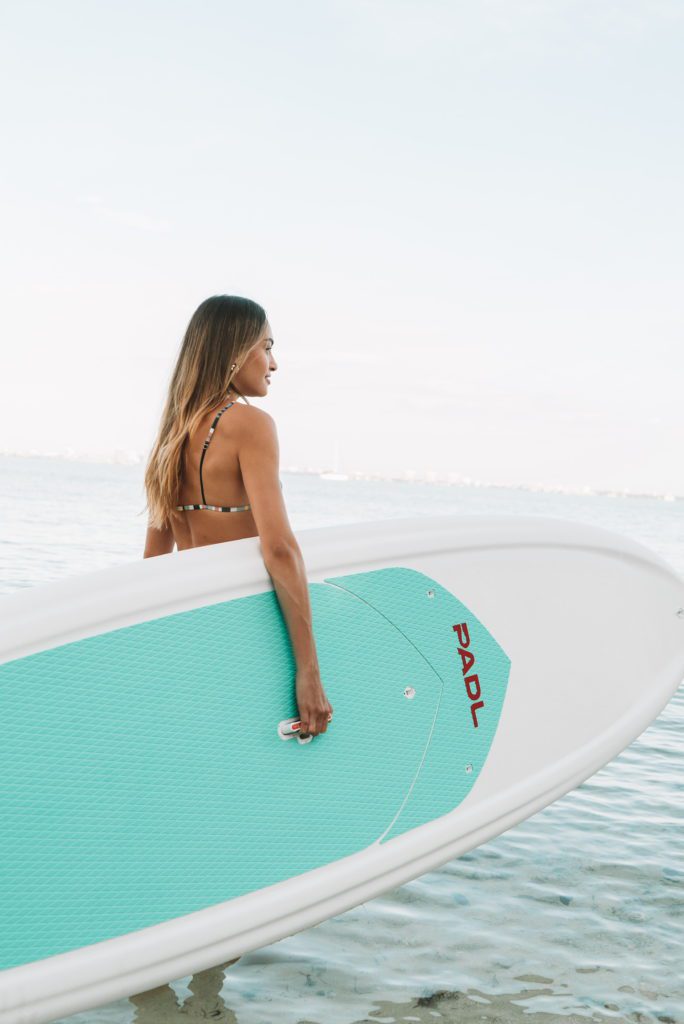New Year’s Resolution: Tips for Paddleboarding for Fitness
The new year is already upon us and many of us have made a resolution to get into shape. Did you know that paddleboarding can be a great way to do that? The best part is, with over 20 PADL stations across the State of Florida, you can now go paddleboarding at a location near you without having to invest in a paddle board, store a paddle board in your house or strap a paddle board on your car. With PADL, getting in shape by riding your nearest body of water is as easy as renting a board from one of our self service stations and getting out there for an hour or two!
Paddleboarding is an extremely versatile sport. For many, it can be a leisurely way to enjoy the water without spending up to much energy. However, for many others, it’s a high intensity cardio sport where you can both burn hundreds of calories per hour, tone up and even build muscle mass!
The difference is in how you paddleboard. To get in a workout on your paddle board, you need to turn your body into an engine that generates enough energy to move the paddle board fast over the water.
Here are 10 tips for making your next on-the-water session as workout-worthy as possible.
1. Use the big muscles
When paddleboarding, many untrained beginners make a motion that involves bending their arms with every stroke. Doing this can make you go very slow on the water and result in only a few calories being burned. Instead, grip with paddle slightly more than shoulder width apart, keep your arms straight and use your back muscles (in particular your latissimus dorsi or “lats”), your side muscles (the intercostals and obliques) and your abdominals (“abs”). Do this by using these muscles to twist your body around with each stroke, remembering to keep your arms straight. Using bigger muscles means driving more power through your stroke, going faster and, by doing so, burning more calories.
2. Squat into an athletic stance
Paddle through the water with your legs slightly bent and muscles around your knees relaxed. This is similar to the “bo” stance that would be familiar to people who have done martial arts before. Not only will this stance lower your center of gravity and help keep you balanced on the board, it will also allow for you to paddle more easily over waves, choppy water and boat wakes. Being able to “handle anything” means that you can more confidently paddle forward without having to stop or slow down. Keeping up a healthy pace throughout your workout, just like in running or cycling, means you can go a longer distance and get in more of a workout on your board.
3. Take short, powerful strokes
Once you are using your big muscles to move the paddle board and squatting into a more athletic stance, the next step is to speed up your stroke rate by paddling faster. An ideal paddleboarding stroke rate is between 45 and 60 strokes per second. That’s around one stroke per second (counting out each second as “one-Mississippi” or “one-one-thousand”). Do this by placing the full blade of the paddle completely down into the water, then pulling the water as hard as you can to about your feet and then taking the blade out of the water and repeating. On each stroke you want to explode with as much force as possible through the water being mindful not to continue the stroke past your feet. Pull out the blade of the paddle from the water before it passes the feet. This last instruction is important since any distance the paddle travels past the feet results in the board slowing down.
Doing this correctly means that the paddle board will be pried forward with each stroke and there will be little time in between for the board to slow down.
4. Measure time and distance
When you paddle at a fast pace, expect to feel some fatigue somewhere within your first 30 minutes on the water. This is normal since your body is both adjusting to the new muscle movements described above and doing some work to remain stable on the paddle board. After a few sessions on the water you will be able to cover more distance and move at a faster pace. Be sure to measure your time and distance on the water so that you can track your progress from session to session.
We have a GPS unit in all of our boards, so when you paddle with a rented PADL board, the app will show how long you have been on the water, how many miles you paddled and even show a map of where you paddled!
5. Paddle with a buddy
There are clear advantages to working out with a friend. Friends can act as accountability partners, people who make sure you show up and put in the work that is needed for you to improve your physique and fitness levels. When it comes to paddleboarding, going paddle boarding with friends can be a fun experience. It’s also safer to go out on the water as a pair or a group of people rather than just by yourself.
So bring your friend(s) down to the station with you! PADL stations have up to 4 paddle boards available at every station, each equipped with a life vest and leash for safety.
6. Crosstrain
Once you get good at paddling fast and hard, the next step is to take your workout to the next level. You can do this by combining other sports and exercises with paddle boarding for a well-rounded workout. While on the water in a safe place away from boat traffic, use the instability of the board to add an element of difficulty to exercises like push-ups, planks or crunches. Another idea is to create a “surf and turf” workout with some parts on the water and others on land. Cycle to a PADL station and then go for a long distance paddle. Paddle out to an island in the bay, and then do some yoga there. The possibilities are endless!
Remember: If you are doing any exercises when your paddle board is on the beach, make sure to take the board completely out of the water to avoid it being carried away by the tide.
7. Hydrate!
It’s important to drink water while you exercise and paddle boarding is no exception. If you are used to light, low-key paddle sessions, you might not have the habit of bringing water out with you. If that’s the case, be sure to change this habit by bringing along a water bottle to your paddle work out.
Proper hydration before, during and after exercise allows your body to replace water loss due to sweating, prevents painful muscle cramps and helps you to recover faster from the session.
8. Explore
One of the best parts about paddleboarding quickly is that you get to cover more water during your sessions and experience scenery and locations that can only be accessed by a small boat or paddle board. Use a map of the area around the PADL paddle board rental station to find bay islands, rivers, lakes, coves, remote beaches and other geographic features. Then paddle out to experience them! Be sure to bring your phone to take pictures and to find your way back to your original launch site using a maps app.
9. Share your progress
Screenshot your paddle session summary and share it on social media! Let your friends know what your up to on the water and be sure to tag in @ridepadl and use the hashtag #paddleshare!
10. Keep up the habit
Exercise works best when made into a habit. Make it a regular activity to get out on the water either alone or with friends. PADL makes it easy to get out on the water for less than $1 per day! PADL memberships are only $24.99 a month and allow you to paddle up to 2 hours per day for a month without having to pay a cent more. What’s more, you can use any of our 20+ self-service paddle board stations around Florida. With value like that you can get fit in no time and have a lot of fun in the process!
So next time you hit the water, make it a work out by using some of the tips above. Looking forward to seeing you out there!



